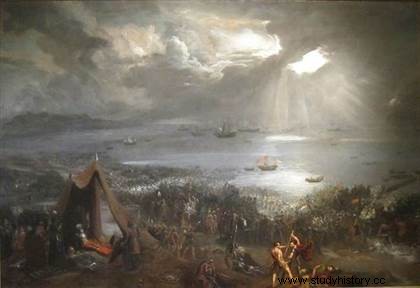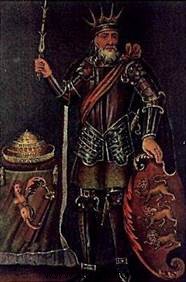 April 23, 1014, The Battle of Clontarf , near Dublin, opposed the armies of the Irish king Brian Boru and the men of Leinster associated with Vikings. We remember that the victory made Brian Boru a national hero having driven the Vikings out of Ireland. Is this really what happened? What is myth and reality? More than 1000 years after this significant episode in Irish history, it is appropriate to return to the circumstances of the battle.
April 23, 1014, The Battle of Clontarf , near Dublin, opposed the armies of the Irish king Brian Boru and the men of Leinster associated with Vikings. We remember that the victory made Brian Boru a national hero having driven the Vikings out of Ireland. Is this really what happened? What is myth and reality? More than 1000 years after this significant episode in Irish history, it is appropriate to return to the circumstances of the battle.
Context of the Viking arrival
The Vikings, warriors from Scandinavia begin their raids in Ireland from 795 to 835 on an ad hoc basis. They attack the monasteries including that of Iona and claim the payment of tribes in cattle. It is for this reason that the round towers appeared near the Monasteries in order to hide the relics there.
Gradually they settled in Ireland until founding a colony in 841 on the current city of Dublin . They are notably at the origin of the creation of the coastal cities of Wexford, Cork, Limerick but also Waterford in 914. It should be noted that the mobility of the Vikings on the longship allowed them to navigate in shallow waters.
During the second half of the 11th century, the raids decreased, this is what is called in the annals "the respite of forty years". We recognize the Vikings their brutality but we must admit that they were excellent traders. The coastal towns created became very flourishing due to fruitful craftsmanship and growing trade inland but also to insular Brittany and the mainland. In the 9th and 10th centuries the cattle used as a means of exchange was even replaced by the ounce of silver and then the currency . They also served as missionaries to Irish kings, including Brian Boru.
Brian Boru's rise to the title of Supreme King of Ireland
 Brian Boru was born in 941, he is one of the 12 sons of Cennétig mac Lorcá in, king of tuadmumu in northern Munster. You should know that Ireland was and is still divided into four provinces s:Munster to the southwest, Leinster to the east ruled by the O'neill dynasty, Connacht to the west and Ulster to the north.
Brian Boru was born in 941, he is one of the 12 sons of Cennétig mac Lorcá in, king of tuadmumu in northern Munster. You should know that Ireland was and is still divided into four provinces s:Munster to the southwest, Leinster to the east ruled by the O'neill dynasty, Connacht to the west and Ulster to the north.
Brian Boru gradually tried to take over the surrounding regions. In 951 he proclaimed himself King of North Munster and in 978 he became King of the entire province having defeated the King of Cashel. Other important dates leading up to his rise should be noted. In 997 he shared Ireland with Mael Sechnaill II (O'Neill's dynasty) then beat in 999 the men of Leinster at Glenn Mama and was made recognize supreme king of Ireland in 1002 by Mael Sechnaill II. He thus put an end to the reign of this dynasty established for six centuries.
As Dr Catherine Swift, Lecturer in Irish History at the University of Limerick, strategy of Brian rested on several pillars. The male members of his family were responsible for administering the sub-kingdoms and churches while the women were married in order to form alliances. Viking encampments were also plundered in order to amass wealth to recruit mercenaries (vikings).
Although having obtained the title of supreme king, Brian Boru continued to assert his authority to secure the allegiance of the provincial kings. He raised an army in 1006 in order to submit the king of the North Flaithbertach Ua Néill who subsequently married one of his daughters, then in 1011 he made King Cenél Conaill of Donegal his vassal. This year 1011 is that of its peak . Rebellions in Dublin and Leinster came to Brian's attention in 1013 and culminated in the decisive Battle of Clontarf on April 23, 1014.
The Battle of Clontarf:Distinguishing myth from reality
The battle which was very bloody took place on April 23, 1014 in old Clontarf. It is more likely that it lasted one day and not several. Geologist Samuel Haughton who studied the event concluded that it took place between 5:30 a.m. and 5:55 p.m. according to high tide times. The battle would have gathered a total of 5000 souls :Brian Boru's men opposed to the armies led by King of Leinster Mael Mordha , the Viking King Sitric Silkenbeard of Dublin as well as the Vikings of Orkney. Victory will go to Boru's men putting to flight their enemies who left before the tide receded.
Conflict between Vikings and Irish or internal rebellion?
The popular belief that goes in the direction of a simple conflict between Vikings and Irish is to be nuanced since there was a mixture of Vikings and Irish on both sides. On the contrary, the Vikings were often used as mercenaries by the kings of Ireland in their quest for power. Ireland had many kings and at that time Brian Boru was the supreme king. In April 1014, some of Brian Boru's warriors are said to have been made up of Scandinavians from Limerick and Waterford. It wasn't the first time he'd called on them. In 980, Brian Boru was notably helped by the Vikings of Waterford to conquer the kingdom of Osraige.
 Brian Boru is therefore not the nationalist hero that we believe. As Pierre Joannon, a specialist in Ireland, explains in his book History of Ireland and the Irish :« He had nothing of the saint of stained glass that the nationalist historians wanted to see in him ". He adds "he was in no way trying to drive the vikings back into the sea, what he wanted was to conquer the supreme power . .
Brian Boru is therefore not the nationalist hero that we believe. As Pierre Joannon, a specialist in Ireland, explains in his book History of Ireland and the Irish :« He had nothing of the saint of stained glass that the nationalist historians wanted to see in him ". He adds "he was in no way trying to drive the vikings back into the sea, what he wanted was to conquer the supreme power . .
Irish historians say the Battle of Clontarf therefore had nothing to do with "Brian's sacrifice defending Ireland against a Norse assault nor with "the liberation of Ireland ". This is respectively the opinion of John Ryan expressed in an essay published in 1938 The battle of Clontarf and Jack Burtchaell, historian and guide in Waterford. It was really, for Brian, to put down a rebellion.
However, in his recent 2014 publication Brian Boru and the Battle of Clontarf , the Irish historian Seán Duffy brings a different point of view. He specifies that the reason for the conflict comes from the ambition of the Scandinavian king of Dublin Sitriuc Silkenbeard, who after his defeat in 999 was determined to regain the city. For Seán Duffy, Brian's main enemies were the Vikings.
Brian Boru, a national hero killed in battle who banished the Vikings from Ireland?
It is highly probable that Boru did not fight. Two reasons can explain this:he was 73 years old and preferred to meditate on this day of Good Friday April 23, 1014. It is said that he was killed after the battle in his tent, by the Viking Bródir, while he was praying.
His other Viking rival,Sitriuc, did not attend the fight either. He had remained inside Dublin City in order to avoid her being picked up. After the battle, he continued to rule Dublin until 1036. Generally speaking, Vikings continued to live in Ireland, trade and intermarry with Irish people.
Consequences and posterity of the Battle of Clontarf
Descendants of Brian Boru, the O'Briens never succeeded in reproducing the same scheme of centralization of power in the face of the regional dynasties which regained their strength. On the death of Brian Boru, Mael Sechnaill regained the throne he had lost in 1002 and again became Supreme King of Ireland until 1022.
The last Viking king was driven out of Dublin in 1052 by the King of Leinster. It is perhaps this date that should be remembered more in terms of the weakening of Scandinavian power, as Pierre Joannon explains "Whoever harbors the ambition to become king of all Ireland must imperatively control Dublin ".
Non-exhaustive bibliography
- Pierre Joannon, History of Ireland and the Irish, Tempus Collection, March 2014
- René Frechet, History of Ireland, What do I know? PUF, Paris, 2001
- Sean Duffy, Historical Atlas of Ireland, Otherwise, Paris, 2002
